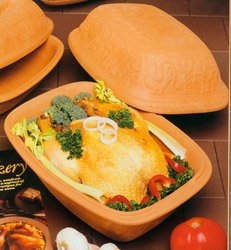Hey Dan,
if you have a modern oven, you won't need one, as they simply mediate the temperature, somewhat like a referee. If you have extreme heat coming from the top of your oven and only mediocre heat coming from the bottom. a clay baker will absorb the two and distribute the heat in a more even fashion, so your chicken or roast isn't getting it too hard from one side.
Since the clay doesn't conduct heat very well, you won't get hotspots, so you won't get any burned areas on your chicken. but if your a good cook this shouldn't happen anyway.
negative sides- you can do the exact same thing with a clay pot you get at a hardware store, and they have holes in the bottom (which will be the top if you use it for cooking) so you can put your probe thermometer through.. you do have one don't you?
they are a pain in the butt to up keep, and you also have to store them. and essentially they do nothing but cook evenly, something your oven is supposed to do already.
Dan if you want my opinion I think if you have lots of money and time on your hands and want something to play with go for it. they certainly make novelty conversation pieces, and if I was retired and had oodles of time and money I might get a large one just for making slow roasted prime rib.
but for normal cooking I think its a waste of time and money. unless of course you don't have an oven and cook with coals, in that case, dig a hole puts lots of coals in it, put your bird in the clay cooker and set it on the coals, top with more coals, then dirt, wait several hours and your ready to eat. Thats all this design is based on. coal and ground cooking. somewhat like a dutch oven.
I don't mean to dampen your parade with negativity Dan, its just the truth, there are 1.2 million kitchen gadgets out there whose sole purpose is to take a buck from your pocket, and this is one of them..


